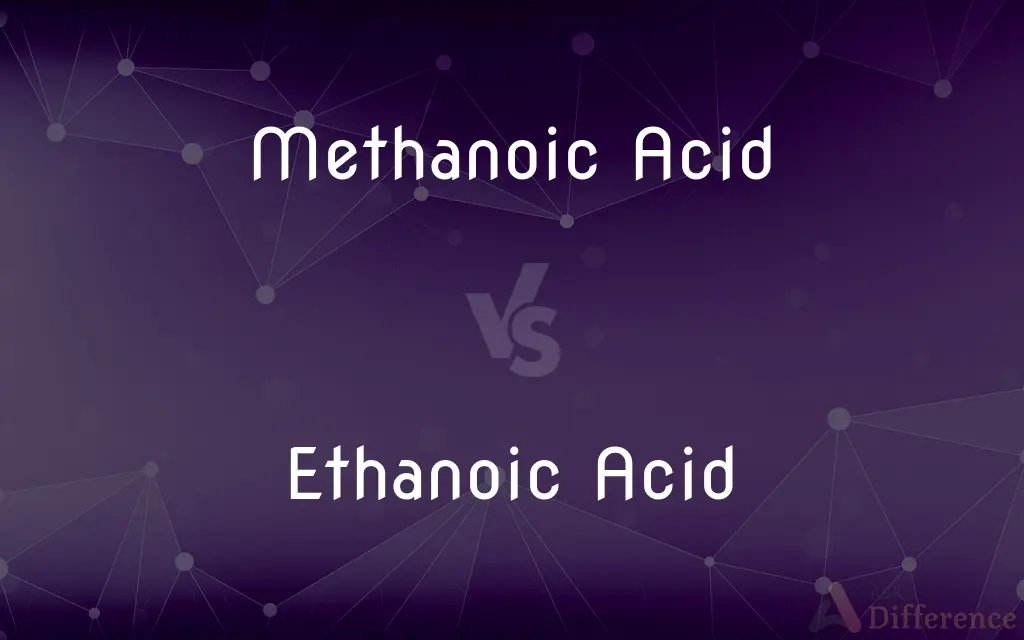Methanoic Acid vs. Ethanoic Acid — What's the Difference?
By Tayyaba Rehman & Maham Liaqat — Published on August 1, 2024
Methanoic Acid (formic acid) is the simplest carboxylic acid, used in nature and industry, while Ethanoic Acid (acetic acid) is known for its role in vinegar and has broader applications.

Difference Between Methanoic Acid and Ethanoic Acid
Table of Contents
ADVERTISEMENT
Key Differences
Methanoic Acid, also known as formic acid, is characterized by having a single carbon atom in its structure, making it the simplest form of carboxylic acid. It is notable for its occurrence in nature, such as in ant venom, and its use in various industrial applications. On the other hand, Ethanoic Acid, better known as acetic acid, contains two carbon atoms, making it slightly more complex. It is most recognized for its pungent smell and sour taste, particularly as the main component of vinegar.
In terms of industrial use, Methanoic Acid is employed in leather production, textile processing, and as a preservative. Its ability to act as a natural antibacterial agent makes it valuable in food preservation as well. Whereas Ethanoic Acid has a wider range of applications, including its use in the chemical industry to produce vinyl acetate monomer (a precursor to polyvinyl acetate and polyvinyl alcohol) and acetic anhydride, as well as in the production of solvents and in food as a preservative and flavoring agent.
Methanoic Acid is known for its strong, pungent odor and is corrosive, requiring careful handling due to its ability to cause burns upon contact with the skin. Ethanoic Acid, while also having a strong smell, is generally less corrosive and toxic, making it safer for use in household settings, such as in cooking and cleaning products.
The chemical properties of Methanoic Acid allow it to act as a reducing agent in certain reactions, a characteristic that is less pronounced in Ethanoic Acid. This property is utilized in industrial processes and organic synthesis, reflecting the chemical versatility of Methanoic Acid. Conversely, Ethanoic Acid's chemical behavior is key in esterification reactions, where it combines with alcohols to produce esters, contributing to the flavor and aroma of many fruits.
Despite their differences, both acids play crucial roles in their respective domains. Methanoic Acid's natural occurrence and industrial utility contrast with Ethanoic Acid's widespread use in food, industry, and household applications. The choice between them depends on the specific needs of their application, highlighting the diversity and importance of carboxylic acids in chemistry and daily life.
ADVERTISEMENT
Comparison Chart
Molecular Structure
One carbon atom
Two carbon atoms
Common Name
Formic Acid
Acetic Acid
Natural Occurrence
Ant venom, stinging nettles
Vinegar, plant and animal cells
Industrial Use
Leather production, preservatives
Solvent production, vinegar, esters
Odor
Strong, pungent
Vinegar-like, sharp
Corrosiveness
Highly corrosive
Less corrosive
Chemical Behavior
Reducing agent
Used in esterification
Toxicity
More toxic, can cause burns
Less toxic
Solubility in Water
Fully soluble
Fully soluble
Compare with Definitions
Methanoic Acid
It acts as a reducing agent in organic syntheses.
Methanoic Acid can reduce certain chemicals in industrial processes.
Ethanoic Acid
A key ingredient in vinegar, known for its sour taste.
Ethanoic Acid gives vinegar its characteristic flavor.
Methanoic Acid
Requires careful handling due to its corrosiveness.
Safety equipment is essential when working with Methanoic Acid.
Ethanoic Acid
Less corrosive than Methanoic Acid, suitable for culinary uses.
Ethanoic Acid is safe to consume in vinegar form.
Methanoic Acid
Used industrially in leather tanning and textile dyeing.
Methanoic Acid facilitates the tanning process of leather.
Ethanoic Acid
Commonly used as a solvent and in the manufacture of chemicals.
Ethanoic Acid is involved in creating solvents for paints.
Methanoic Acid
The simplest carboxylic acid with antibacterial properties.
Methanoic Acid is used as a preservative in livestock feed.
Ethanoic Acid
Used in the production of synthetic fibers and plastics.
Ethanoic Acid is a precursor in making polyvinyl acetate.
Methanoic Acid
Known for its natural occurrence in ants and nettles.
The sting of an ant releases Methanoic Acid, causing irritation.
Ethanoic Acid
Forms esters that contribute to the flavors of fruits and wines.
Ethanoic Acid reacts with alcohol to form fruity esters.
Common Curiosities
What are the industrial uses of Ethanoic Acid?
It's used in making solvents, synthetic fibers, and as a food preservative.
Can Methanoic Acid be found in nature?
Yes, it's found in ant venom and stinging nettles.
Can both acids be used in leather production?
Methanoic Acid is primarily used in leather production, not Ethanoic Acid.
How do Methanoic Acid and Ethanoic Acid differ in structure?
Methanoic Acid has one carbon atom, while Ethanoic Acid has two.
Is Methanoic Acid more corrosive than Ethanoic Acid?
Yes, Methanoic Acid is more corrosive and requires careful handling.
What makes Ethanoic Acid less toxic than Methanoic Acid?
Its chemical structure and lower corrosiveness make it safer for consumption and use.
What is Ethanoic Acid?
A carboxylic acid best known as the main component of vinegar, with broad applications.
How are Methanoic Acid and Ethanoic Acid used in food?
Methanoic Acid is used as a preservative, while Ethanoic Acid is used in vinegar and as a flavoring agent.
What is Methanoic Acid?
A simple carboxylic acid found in nature and used in various industrial applications.
Which acid is a better solvent?
Ethanoic Acid, due to its solvent properties and application in industrial processes.
Can Ethanoic Acid be used as a preservative like Methanoic Acid?
Yes, it's used as a preservative and flavoring agent in foods.
How do their roles in chemical reactions differ?
Methanoic Acid acts as a reducing agent, while Ethanoic Acid is used in esterification.
Why is Methanoic Acid more toxic?
Its higher corrosiveness and potential to cause burns make it more hazardous.
How does the presence of Ethanoic Acid affect food flavor?
It imparts a sour taste and aroma, particularly in vinegar and fermented products.
What safety precautions are necessary when handling Methanoic Acid?
Use of protective gear and proper ventilation due to its corrosiveness.
Share Your Discovery

Previous Comparison
Acetone vs. Mineral Spirits
Next Comparison
Manuka Honey vs. Raw HoneyAuthor Spotlight
Written by
Tayyaba RehmanTayyaba Rehman is a distinguished writer, currently serving as a primary contributor to askdifference.com. As a researcher in semantics and etymology, Tayyaba's passion for the complexity of languages and their distinctions has found a perfect home on the platform. Tayyaba delves into the intricacies of language, distinguishing between commonly confused words and phrases, thereby providing clarity for readers worldwide.
Co-written by
Maham Liaqat












































